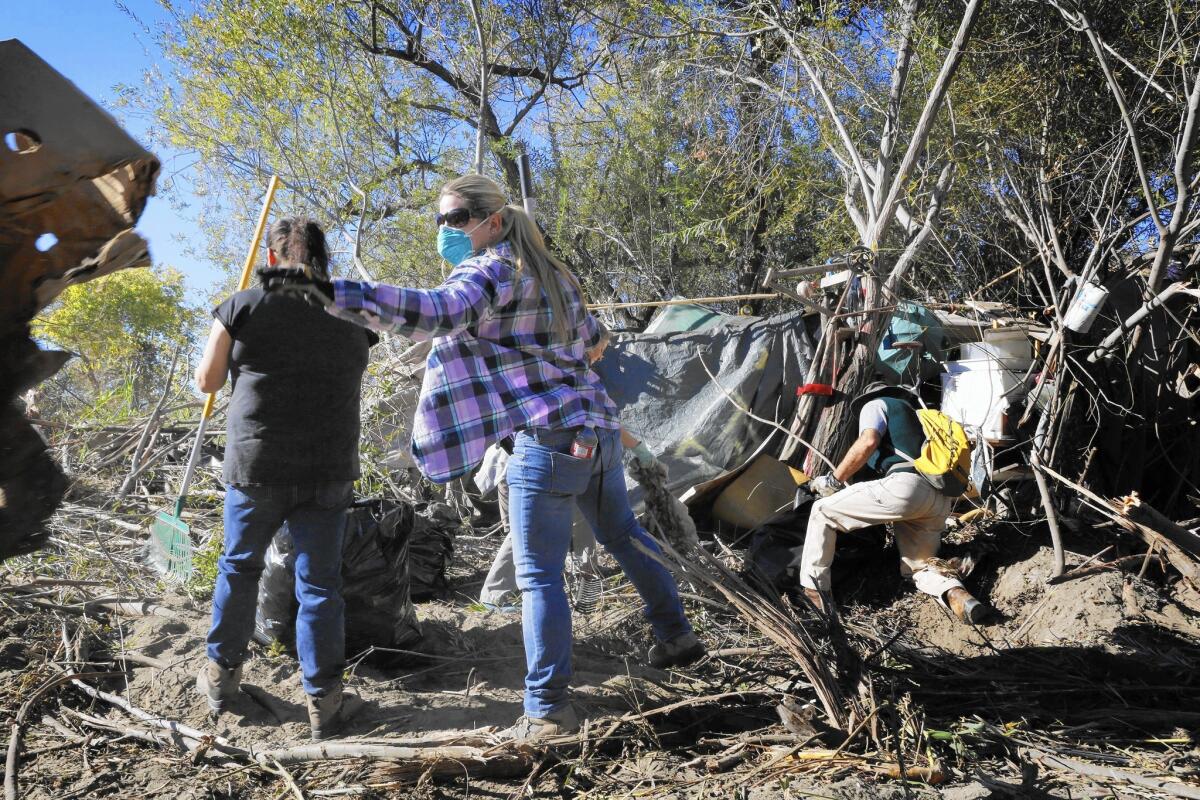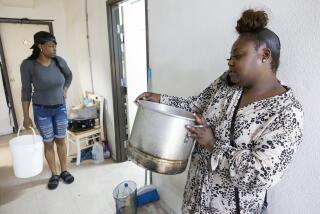Cleaning out Big Tujunga Wash: Whose job is it?

Volunteers clean out a homeless encampment at Big Tujunga Wash.
As a backhoe and skip loader ripped away the screen of arundo stalks, the outskirts of a hidden village of huts slowly came into view. Most were made from tents, tarps, blankets and sticks.
A few stragglers slunk away, dragging what they could in suitcases and rickety carts along the sand and boulder surface of Big Tujunga Wash.
The excavation of the invasive bamboolike arundo began Nov. 7 as more than 100 volunteers donned masks and gloves to begin the Herculean task of cleaning up the wash. Among the items collected: piles of clothing, mattresses, dressers, tires, box springs, hypodermic needles, a big-screen TV and a wheelless motor home.
The cleanup — and summary eviction of as many as a hundred squatters — on 300 acres of private land a little more than a mile upstream from Hansen Dam was organized and financed by property owners of the Riverwood community of Sunland, a hillside enclave of about 35 homes whose residents come and go on a single road crossing the wash.
Over the last three years, the growth of the shanty village has despoiled a public resource and subjected homes along Oro Vista Avenue to burglaries and the threat of violence, said Brian Schneider, who spoke for the residents.
But the encampments of Tujunga Wash have fallen into a tangle of inconsistent rules for public and private land and conflicting perceptions of homelessness.
Among the volunteers, many of whom did not want to be named, a whistle-while-you-work spirit was offset by open animosity for public officials —particularly 7th District Councilman Felipe Fuentes — who, they contend, have dismissed their calls for help out of deference to the rights of homeless people.
In Tujunga Wash, Schneider said, “homeless” is a “euphemism for people who are breaking into our cars, trying to break into our homes, selling drugs. I’m not safe in my own neighborhood.”
Fuentes countered that the city, unlike private property owners, is limited by constitutional constraints and its own homeless ordinance from removing people from public property and confiscating their property, while private-property owners are responsible for abating nuisances on their land.
He agreed that there is a health and human safety problem in the wash. But the solution, he said, is a mix of enforcement and service with the emphasis on service.
“The crisis is one of trying to address the needs of this constituency,” Fuentes said, using the language of homeless outreach. “It is one of getting them into the coordinated entry system...It’s an attempt to stabilize an individual.”
The cleanup last weekend was the continuation of a saga that began in September when the Los Angeles Sanitation Bureau cleaned the upriver portions of the wash, a vast area owned by the city and the Los Angeles Department of Water and Power.
A spokeswoman for Fuentes’ office said the primary objective was the safety of the inhabitants.
“When it starts raining, there will be so much water it will be dangerous to them,” said Cheryl Getuiza.
That nine-day cleanup operation on the upriver portion of the wash, costing $300,000, produced 163 tons of trash — roughly 41 truckloads — and forced an undetermined number of homeless downriver.
Their options included climbing out of the wash and heading into the streets of Sunland, moving south onto the private land owned by Jeong Shin, an elderly woman who does not live in Riverwood, or accepting temporary shelter offered by two homeless agencies whose outreach workers were on hand. Few chose the shelter.
Eileen Bryson, spokeswoman for the Los Angeles Homeless Services Authority, said the agency contacted 70 people during the city cleanup, but only three accepted housing.
Nathaniel Vergow of the Los Angeles Family Housing Corp., which makes regular forays into the wash, said several people relocated into temporary shelters, and the agency has obtained a permanent housing voucher for one and was working with several others.
Some of the dislocated tried to move south of Oro Vista onto a portion of the 282 acres owned by the Mountains Recreation and Conservation Authority, but were turned away. The authority has its own ordinance, which prohibits, among other activities, overnight camping on its land.
Ranger David Aceves said he makes weekly visits to make sure no one is living there.
‘I hike it,” he said.”They’ll start moving in. I catch them. If you don’t catch it, look what it becomes.”
Schneider said residents were alarmed to see that some of the displaced were immediately moving back onto the city property.
“They didn’t do anything but make it better to live there,” he said. “What a colossal waste of money. They should have gone in there and taken out the arundo and made it a moonscape.”
The residents hired tractors to do just that on the Shin property early in October. That project came to an abrupt end when some squatters allegedly threatened them.
The discovery of a woman’s decomposing body Oct. 17 raised the level of apprehension, and solidified the community’s contention that the wash was not merely a refuge for the down-and-out, but a haven for drug dealing and crime.
The woman was identified as Julia Moniz, a 34-year-old mother of two who had a troubled history but was living with her mother when she disappeared Oct. 5.
When the landowners’ cleanup resumed Nov. 7, Ginny Moniz was there to show her support. She said she did not know why her daughter went to the encampment. Her death remains under investigation.
By midmorning Sunday, the refuse had filled three roll-off containers. Large piles of trash remained scattered across the quarter-mile-wide wash.
A few of the people displaced had stayed overnight in the park. They took turns washing their hair in the drinking fountain and shushing two chained dogs that lunged at passers-by.
A woman who gave her name only as Bri said she was working with L.A. Family Housing for a voucher, but needed to get an ID and Social Security number first.
She said she had lived in the wash two years.
“As long as you keep your own clean, it was all right,” she said. “It’s like camping.”
Fuentes, the councilman, said he was pleased that private citizens had taken the initiative to clean up the wash. But he said it would continue to be the property owners’ responsibility to keep it that way.
Shin did not respond to a message left at her downtown business. But resident Arthur Miner, acting as her spokesman, said the task is too big to hold her responsible.
“I had no idea of the magnitude of the problem,” Miner said. “We’ve expended now $15,000. It’s shocking that you’ve got citizens doing this.”
Shin bought the land on a whim about 20 years ago and has never been able to develop it, he said. She still hopes to build four ranch houses on the hillside, but the portion in the wash is suitable only for recreation.
Schneider, the spokesman for the residents, said the city is making the private owners’ job impossible by failing to keep its own property clean.
As the residents suspected, officers who patrolled the wash during the cleanup said they have already spotted new settlements on the city land, only a month after the old ones were cleared away.
Schneider said that although the land is private, it is also a public waterway under state and federal protection. Therefore, he said, the property owners need help in keeping it pristine.
“It is deplorable,” he said Sunday, standing in a clearing in the arundo amid six buckets filled with human feces.
“This is part of our water supply,” he said. “This is a beautiful resource for the people of Los Angeles.”
ALSO
El Niño ‘is here, and it is huge,’ as officials race to prep for winter
As fewer Californians pass the bar, are LSAT scores an early indicator of success?
Steve Lopez: What’s wrong with L.A. Unified’s leadership? Answer: Just about everything
More to Read
Sign up for Essential California
The most important California stories and recommendations in your inbox every morning.
You may occasionally receive promotional content from the Los Angeles Times.











